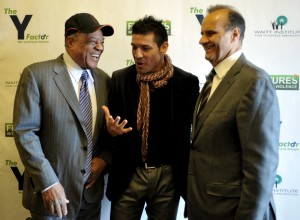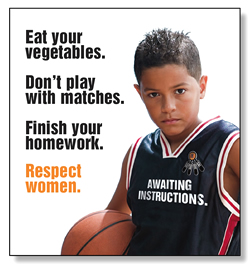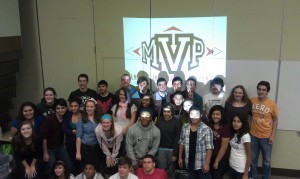We Were Looking for a Few Good Men

Willie Mays, Sergio Martinez, and Joe Torre on April 12, 2012 at a gathering of national leaders in violence prevention called “The Y Factor-Men Leading by Example”. Futures without Violence’s International Center to End Violence. Photo by Joseph Driste courtesy of Futures without Violence
“There are a lot of good guys out there, who are dying for the opportunity to do something, because, after all, it’s their mothers, sisters, daughters, and friends who are being victimized” Municipal Court Judge Ron Adrine
Almost fifteen years ago, the Waitt Foundation and Futures Without Violence went looking for a few good men and…we found them. And then, they found us. What we learned was what we already knew. There weren’t a few…there were many. This is just a piece of the story of our involvement with the men who made the decision to stand with women, and use their voices, their power, their positions, and their resources to make a difference in preventing violence against women and girls. Standing on the shoulders of women leaders, and like those women, they HAVE made a difference.
It started for us in the late 1990’s. A former colleague and domestic violence activist, Judy Stafford, approached me with an idea. She asked us to think about new partners in domestic violence prevention-men. It wasn’t completely new. There were men already out there doing the work, such as Mentors in Violence Prevention founder Jackson Katz, Men’s Resource’s Center founder Steven Botkin, former Philadelphia Eagles player Don McPherson, NOMAS, and the venerable White Ribbon Campaign in Canada. They were connecting with others and starting to speak up and speak out, working collaboratively with the women who were pioneers in the anti- battering movement in America and elsewhere. But, as Judy saw it, the budding movement needed some help from men from outside the movement, men in politics, media, sports, and business. She asked us, and more specifically, asked my brother Ted to not only consider putting the Waitt Foundation’s considerable funds behind the idea, but his voice as well.
He did consider it, and he acted. His green light took us to our crucial first contact with Esta Soler at Futures Without Violence, then the Family Violence Prevention Fund. Esta, already a national leader in the field of violence prevention, is a woman who gets things done, and those things tend to be big. Her advice? If we wanted men in the movement, we’d have to ask them not only “if” they’d do it, but “how” they’d do it. We asked and they told us. Our 2000 Peter D. Hart Research national poll said that they would get involved, they just hadn’t been asked. The “how” was that they were willing to talk to boys. Out of that research came a multi-year Advertising Council campaign that ran from 2002-2006 that asked men across the country to be role models and mentors to boys coming of age. It hadn’t been done before and it began to move needles. From a baseline study in 2001, we learned that only 29% of men had talked to boys about the issue of relationship violence. By 2007, that number had increased to 55%.

“Awaiting Instructions” campaign, part of Future’s without Violence multi- year marketing campaign with the Ad Council
During the same time period Ted became the first chairman of what is called “The Founding Fathers”, a group of men from all walks of life committed to public action and public statements about ending violence against women and girls. He and other men made phone calls to men in leadership positions across the country to not only lend their voice, but give their resources to this issue. On Father’s Day 2003, 350 men joined in an historic public statement to call for an end to violence against women and children. Their pledge along with signatures of all those men, appeared as a full-page ad in the New York Times.Over the next few years, many of those men joined activists and policy leaders at events in New York and Washington D.C., working with women and men who were “in the trenches” in any way they could.
One of those ways to get into the trenches was to gather a group of activists and sports figures, such as former Boston Celtics player and coach M. L. Carr, to create an on ground program that Futures Without Violence, the leader of this effort, called “Coaching Boys into Men”. Again, when men were asked how to help, they, along with the women who are always at the table, came up with something tangible. In this case, the program that was developed used the influence of coaches to talk to young male athletes about respect for girls and women. The program premiered in 2005 and was introduced in all 50 states and 23 countries. It’s still growing.
We began to see a sea change in the sheer numbers of men coming to the table to help. Baseball legend Joe Torre’s mother suffered horrific abuse at the hands of her husband, and prompted Joe to start his own foundation called “Safe At Home”. He remains one of our strongest allies. Mark Wynn, a former police lieutenant, tells the story of being the stepson of a man he calls ” a criminal”, who beat his mother before the time there were laws on the books. Mark now devotes his life to speaking to future law enforcement professionals and others in hopes that they’ll begin to understand the dynamics of domestic violence. People touched by what Gloria Steinem calls “original violence” are in your town and in your neighborhood and many of them are men like the man I had lunch with today, a former politician, whose mother was brutally murdered by a stepfather when he was in the 5th grade. Joining those men who may have acted to prevent the violence they personally witnessed were other men, like my brother and so many others, who may not have been touched by family violence, but could see how vital curbing this violence is to the future of our country and to our world.
We can see the traction in this movement against violence and see where it’s making a difference. Men’s groups such as Men Can Stop Rape, A Call to Men, and Men Stopping Violence began to grow and expand. Jackson Katz, Michael Kimmel, Byron Hurt, Tom Keith, Joe Ehrmann and others were writing books, making films, and speaking to college campuses about the importance of engaging men and boys. The Global MenEngage Alliance has more than 300 non governmental organizations worldwide. A CDC-funded evaluation of Futures’ “Coaching Boys into Men” found that athletes who participated were significantly more likely to report intentions to intervene when witnessing abusive or disrespectful behaviors among their peers than those not in the program. “Mentors in Violence Prevention”, a peer to peer in- school bystander program we have partnered with for 13 years, shows promise in improving school culture – with a significant decrease in the percent of students perpetrating one or more bullying behaviors in schools where MVP has been implemented. Those are just two of the programs now doing the crucial work educating young people. “Engaging Men” as allies in educating young men and women is now a strategy recognized by the State Department, the Department of Justice, the Clinton Global Initiative, the World Health Organization, and the White House.
The story doesn’t end there. There are many battles still raging on the front lines. Though progress is being made and domestic violence has decreased, the numbers are still staggering. Women suffer two million injuries from intimate partner violence each year, and an estimated seven million children live in families in which severe partner violence occurred. Despite this, vital funds and services to victims in my own home state of Iowa, as in many others, are being cut.

The future. Kids on the ground as part of Mentors in Violence Prevention in Sioux City, Iowa 2012 Photo by Dr. Alan Heisterkamp courtesy of the Waitt Institute for Violence Prevention
It takes time to change social norms that accept violence as a part of life. Women have been working on the issue of family violence for over a century. Men as allies are new to this movement, but as women are half of humanity, so are men. The majority of men don’t batter, but some of them like Joe Torre and Mark Wynn have been witnesses to assaults on their sisters, daughters, mothers, colleagues, and friends. Every man can do something to help and do it in concrete ways. They can give to vital protection programs for women and children such as local shelters, they can speak to policy leaders in their town and in their state, they can donate time and resources to school education programs, and like the men I’ve talked about, they can speak up, speak out, and most importantly, pass the message on to future generations. While the few who began to act have now become the many, we hope that someday soon, there will be many more.
Comments (0)
